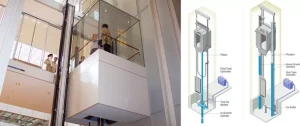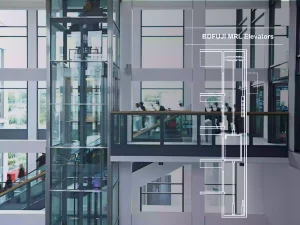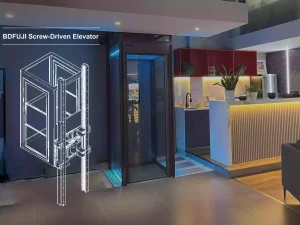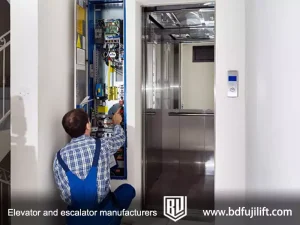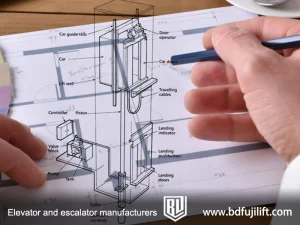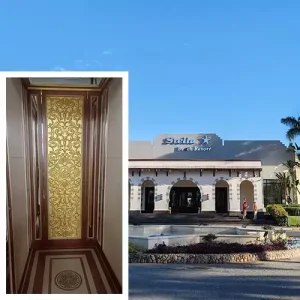Low rise elevators help people move easily in short buildings. They are made for places with just a few floors, like homes, offices, or small shops.
This guide will show you what a low rise elevator is, how it works, and why it’s a smart choice for low buildings today.
What Is a Low Rise Elevator?
A low rise elevator is a type of elevator made for buildings with only a few floors. It helps people move between levels quickly and safely. These elevators are common in homes, small offices, and low-rise apartments.
Low rise elevators are usually slower and simpler than high-rise elevators. They can use different systems, like hydraulic or traction, and often don’t need a machine room. This makes them a good choice for places with limited space.
What Are the Main Characteristics of Low Rise Elevators?
Low rise elevators are built for short buildings and have features that make them simple, useful, and safe. These features help them work well in homes, small offices, and other low-rise spaces.
- Simple Design: These elevators often use basic systems, like hydraulic or MRL (machine room-less). That means they are easier to install and don’t need a big machine room.
- Lower Cost: Low rise elevators usually cost less than high-rise models. They are a good choice for small buildings with limited budgets.
- Space-Saving: These elevators are great for places with little space. Some models can even fit inside walls or tight corners.
- Easy Maintenance: Because of their simple parts, it’s easier and cheaper to take care of low rise elevators over time.
- Quiet Operation: Many low rise elevators make less noise, which is good for homes and quiet buildings.
What Are the Common Types of Low Rise Elevators?
Low rise elevators come in different types to fit small buildings. Each type works in its own way and has special features for homes, offices, or shops.
1. Hydraulic Elevators
Hydraulic elevators use a piston to lift the car. A pump pushes oil into a cylinder to move the elevator up.
Common Uses:
-
Homes with 2–4 floors
-
Small buildings without much space
-
Areas with low traffic
Price Range: $10,000 – $25,000 USD Lifespan: 15–20 years
Main Features:
-
No need for a deep pit or overhead room
-
Smooth and quiet ride
-
Slower speed but strong lifting power
2. MRL Traction Elevators (Machine Room-Less)
MRL elevators use ropes and a motor to lift the car. They don’t need a separate machine room.
Common Uses:
-
Small office buildings
-
Hotels or apartments under 6 floors
-
Buildings with limited space
Price Range: $15,000 – $30,000 USD Lifespan: 20–25 years
Main Features:
-
Saves space
-
Energy efficient
-
Can go faster than hydraulic models
3. Screw Drive Elevators
Screw drive elevators move the cabin by turning a long screw shaft.
Common Uses:
-
Private homes
-
Villas or duplexes
-
Retrofits in existing houses
Price Range: $12,000 – $30,000 USD Lifespan: 10–20 years
Main Features:
-
Simple design
-
Works without oil
-
Easy to install and maintain
What Are the Main Factors That Affect Low Rise Elevator Cost?
The price of a low rise elevator can change based on different things. Here are the most common factors that affect the cost:
-
Type of Elevator: Hydraulic, traction, or screw drive elevators all have different prices. Some are more expensive because of the parts they use.
-
Number of Floors: The more floors your elevator needs to travel, the higher the cost will be.
-
Weight Capacity: Elevators that carry more people or heavy loads need stronger parts, which cost more.
-
Design and Size: Custom designs, bigger cabins, or glass doors can make the price go up.
-
Installation Conditions: If your building needs extra work (like cutting walls or building a shaft), the price will increase.
-
Technology and Features: Adding things like automatic doors, smart screens, or backup power will raise the total cost.
-
Maintenance and Service: Some elevators cost less to buy but more to maintain over time. This affects the total cost in the long run.
Conclusion
Low rise elevators are an important part of modern buildings. They make it easier and safer for people to move between floors in homes, offices, and small spaces.
But to enjoy all their benefits, it’s important to choose the right type, follow the correct setup steps, and use the elevator safely every day.
When low rise elevators are used the right way, they help save space, improve comfort, and support a better life for everyone who uses them.
FAQ
Do Low Rise Elevators Need a Pit?
A low rise elevator often needs a small space under the shaft, called a pit. This pit helps make the elevator work safely and smoothly.
The pit gives room for parts like the buffer spring and bottom of the elevator car. It also helps if there is water—some pits need a pump to remove water in case of leaks or rain. This is called a sump pump.
But not all buildings need a deep pit. Some low rise elevators, like screw drive or machine-room-less (MRL) models, can work with a very shallow pit—or even no pit at all.
So, whether you need a pit depends on:
- The type of elevator
- The building’s design
- Local safety rules
If the building has problems with water, it’s smart to install a small pit with a pump. This keeps the elevator dry and safe to use.
Which Companies Make Low Rise Elevators?
Many companies around the world make low rise elevators. These companies offer safe, smart, and space-saving elevator options for homes, offices, and small buildings.
Here are some well-known elevator companies that make low rise models:
- Otis: One of the oldest elevator companies. They make home elevators and small building lifts with modern designs.
- BDFUJI: A growing brand that makes low rise elevators with compact design, easy installation, and lower cost. Great for modern homes and villas.
- Schindler: Known for quiet and energy-saving elevators. They offer machine-room-less (MRL) options for low-rise use.
- Thyssenkrupp: Makes stylish and space-friendly home elevators. Some models don’t need a deep pit or machine room.
- KONE: Offers small elevators with smooth rides and smart control panels. Good for both homes and businesses.
- Mitsubishi Electric: Their elevators are strong and long-lasting. Some are built just for short buildings.
These companies offer different types and prices of low rise elevators, so it’s good to compare before buying.




